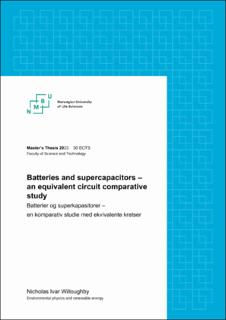| dc.contributor.advisor | Professor Dr. Jorge Mario Marchetti | |
| dc.contributor.author | Willoughby, Nicholas Ivar | |
| dc.date.accessioned | 2023-07-06T16:27:45Z | |
| dc.date.available | 2023-07-06T16:27:45Z | |
| dc.date.issued | 2023 | |
| dc.identifier | no.nmbu:wiseflow:6839571:54592236 | |
| dc.identifier.uri | https://hdl.handle.net/11250/3076757 | |
| dc.description.abstract | Using more renewable power is necessary to reach the sustainability goals set by the United
Nations and reducing greenhouse gas emissions. Increased use of renewable energy is also
required as many different sectors need to be electrified. Furthermore, the war in Ukraine has
shown that relying on a foreign state’s energy supply to guarantee enough power is not a
viable strategy, and that more locally produced energy is needed. In order to achieve these
ambitions, it is necessary to be able to store energy. Subsequently, both efficient
supercapacitors and batteries are needed.
In this thesis a review of batteries and supercapacitors were carried out. First a short literature
review was performed to see where batteries and supercapacitors are being used and how
they perform. A second literature study was performed to study the modelling of batteries
and supercapacitors. Equivalent circuit models for both batteries and supercapacitors were
made. Two different batteries and supercapacitors were chosen for simulations. The batteries
simulated were based on lithium ion and NiMH technology. The supercapacitors were chosen
from two popular brands; Nichion and Eaton. The parameters for the different devices were
decided by assuming that they behaved the same way as found in other studies in the
literature. The devices were then simulated using a resistive load for a discharge cycle. Longrange
simulations using CC-CV profiles were used.
Simulations showed that batteries were able to provide a charge for a longer time compared
to the supercapacitors during discharging on a resistive load. During the CC-CV long-range
simulation the Eaton 400F supercapacitor had the highest power output. Both supercapacitors
were able to accomplish more cycles than both the batteries. The NiMH was able to do ½ cycle
more than the lithium battery. The SOH calculations showed that the Nichion supercapacitor
was able to achieve the most cycles. The lithium battery was able to perform more cycles than
the NiMH battery. | |
| dc.description.abstract | | |
| dc.language | eng | |
| dc.publisher | Norwegian University of Life Sciences | |
| dc.title | Batteries and supercapacitors – an equivalent circuit comparative study | |
| dc.type | Master thesis | |
